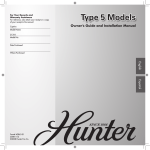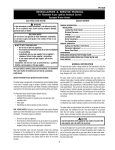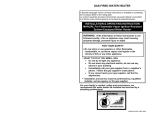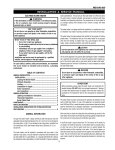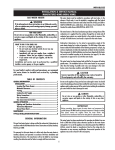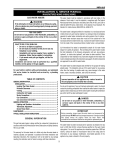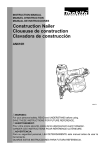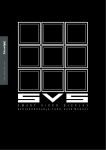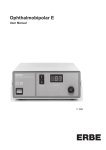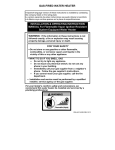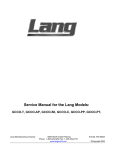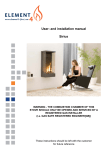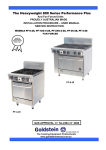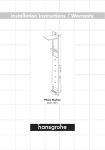Download L:\LIT\English - resized - Brad
Transcript
BF/DV-GAS-I&S INSTALLATION & SERVICE MANUAL BALANCED FLUE/ DIRECT VENT GAS WATER HEATER This water heater must be installed in accordance with local codes or, in the absence of local codes, the National Fuel Gas Code, ANSI Z223.1-Latest Edition) and/or in Canada CAN/CGA B149 Installation Codes (Latest Editions). The warranty for this water heater is in effect only when the water heater is installed, adjusted, and operated in accordance with these Installation and Operating Instructions. The manufacturer will not be held liable for any damage resulting from alteration and/or failure to comply with these instructions. WARNING: If the information in these instructions is not followed exactly, a fire or explosion may result causing property damage, personal injury or death. FOR YOUR SAFETY Do not store or use gasoline or other flammable, combustible, or corrosive vapors and liquids in the vicinity of this or any other appliance. This water heater is not design certified for installation in a mobile home. Such an installation may create a hazardous condition and will nullify the warranty. This water heater has been designed and certified for the purpose of heating potable water. The installation and use of this water heater for any purpose other than the heating of potable water may cause damage to the water heater and create a hazardous condition and nullify the warranty. WHAT TO DO IF YOU SMELL GAS • Do not try to light any appliance. • Do not touch any electrical switch; do not use any telephone in your building. • Immediately call your gas supplier from a neighbor’s telephone. Follow the gas supplier’s instructions. • If you cannot reach your gas supplier, call the fire department. Installation and service must be performed by a qualified installer, service agency or the gas supplier. CAUTION Incorrect operation of this appliance may create a hazard to life and property and will nullify the warranty. Do not use this appliance if any part has been submerged in water. Immediately call a qualified service technician to inspect the appliance and to replace any part of the control system and any gas control which has been under water. Depending upon the individual circumstances, it may be necessary to replace the entire water heater. For your family’s comfort, safety and convenience, we recommend this water heater be installed and serviced by a plumbing professional. DANGER Do not store or use gasoline or other flammable, combustible, or corrosive vapors and liquids in the vicinity of this or any other appliance. TABLE OF CONTENTS GENERAL INFORMATION............................................................. 1 INSTALLATION......................................................................... 2 Locating The Water Heater ................................................. 2 Minimum Clearances ........................................................... 2 Optional Direct Vent-Air Intake Terminal Guard ................ 3 Venting ............................................................................... 3 Horizontal and Vertical Vent-Air Intake Lengths ............... 4 Vent-Air Intake System Installation .................................. 6 Water Connections ............................................................. 8 Gas Connections ................................................................. 9 GENERAL OPERATION ................................................................. 10 Lighting and Shutdown Instructions .................................. 10 Thermostat Adjustment ...................................................... 11 Burner Flame Check ............................................................. 11 MAINTENANCE ............................................................................ 11 Vent-Air Intake Kits ........................................................... 12 INSTALLATION INSTRUCTIONS FOR POTABLE WATER AND SPACE HEATING .......................................................................... 12 IMPORTANT Before proceeding, please inspect the water heater and components for possible damage. DO NOT install any damaged components. If damage is evident then please contact the supplier where the water heater was purchased or the manufacturer listed on the rating plate for replacement parts. Make sure that you check the rating plate and combination gas control on the water heater to be certain that the type of gas being supplied corresponds with the marking on the rating plate and combination gas control. A sacrificial anode is used to extend tank life. The removal of this anode, for any reason, will nullify the warranty. In areas where water is unusually active, an odor may occur at the hot water faucet due to a reaction between the sacrificial anode and the impurities in the water. If this should happen, an alternative anode may be purchased from the supplier that installed this water heater. This will minimize the odor while protecting the tank. Additionally, the water heater should be flushed with appropriate dissolvers to eliminate any bacteria. GENERAL INFORMATION This gas-fired water heater’s design is certified by CSA International under the American National Standard Z21.10.1 - (as indicated on the rating plate) and CSA 4.1-M - (as indicated on the rating plate). 1 BF/DV-GAS-I&S INSTALLATION WHAT TO DO IF YOU SMELL GAS • Do not try to light any appliance. • Do not touch any electrical switch; do not use any telephone in your building. • Immediately call your gas supplier from a neighbor’s telephone. Follow the gas supplier’s instructions. • If you cannot reach your gas supplier, call the fire department. DO NOT OPERATE APPLIANCE UNTIL LEAKAGE IS CORRECTED! Locating The Water Heater WARNING Water heaters are heat producing appliances. To avoid damage or injury there shall be no materials stored against the water heater or vent-air intake system and proper care shall be taken to avoid unnecessary contact (especially by children) with the water heater and vent-air intake components. UNDER NO CIRCUMSTANCES SHALL FLAMMABLE MATERIALS, SUCH AS GASOLINE OR PAINT THINNER BE USED OR STORED IN THE VICINITY OF THIS WATER HEATER, VENT-AIR INTAKE SYSTEM OR IN ANY LOCATION FROM WHICH FUMES COULD REACH THE WATER HEATER OR VENT-AIR INTAKE SYSTEM. WARNING DO NOT ATTEMPT TO LIGHT ANY GAS APPLIANCE IF YOU ARE NOT CERTAIN OF THE FOLLOWING: • Liquefied petroleum gases/propane gas and natural gas have an odorant added by the gas supplier that aids in detection of the gas. • Most people recognize this odor as a “sulfur” or “rotten egg” smell. • Other conditions, such as “odorant fade” can cause the odorant to diminish in intensity, or “fade”, and not be as readily detectable. • If you have a diminished sense of smell, or are in any way unsure of the presence of gas, immediately contact your gas supplier from a neighbor’s telephone. • Gas detectors are available. Contact your gas supplier or plumbing professional for more information. DO NOT install the water heater in any location where gasoline or flammable vapors are likely to be present. Water Heaters in residential garages shall be installed so that all burner(s) and burner ignition device(s) are located not less than 18 inches (46 cm) above the floor and shall be located, or protected, to avoid physical damage. For other installations refer to local codes. In the absence of local codes, the water heater shall be installed in compliance with the National Fuel Gas Code, ANSI Z223.1 - (Latest Edition) and/or in Canada, CAN/CGA B149 Installation Codes (Latest Editions). The water heater must be located close enough to the outside wall to keep the venting distance within the maximum distance described in the installation instructions. Note: The direct vent-air intake terminal must be installed on a vertical wall. Read the venting section in this installation instruction manual before locating the water heater. The location of this water heater is of the utmost importance. Before installing this water heater, read the installation section of these instructions. After reading these installation and operating instructions, select a location for the water heater where the floor is level and is easily accessible to gas and water supply lines. DO NOT locate the water heater where water lines could be subjected to freezing temperatures. Make sure the cold water pipes are not located directly above the gas control so that condensate during humid weather does not drip on the controls. This water heater must be located in an area where leakage of the tank or water line connections and the combination temperature and pressure relief valve will not result in damage to the area adjacent to the water heater or to lower floors of the structure. When such locations cannot be avoided, a suitable drain pan, adequately drained, be installed under the water heater. The pan must not restrict combustion air flow. The drain pan must be no greater than 1-1/2 inches (3.8 cm) deep and have a minimum length and width of at least four (4) inches (10.2 cm) measured from the jacket of the water heater. The drain pan, as described above, can be purchased from your plumbing professional. The drain pan must be piped to an adequate drain. The piping must be at least 3/4 inch (1.9 cm) in diameter and pitched for proper drainage. Water heater corrosion and component failure can be caused by the heating and breakdown of airborne chemical vapors. Examples of some typical compounds that are potentially corrosive are: spray can propellants, cleaning solvents, refrigerator and air conditioning refrigerants, swimming pool chemicals, calcium and sodium chloride, waxes and process chemicals. These materials are corrosive at very low concentration levels with little or no odor to reveal their presence. NOTE: DAMAGE TO THE WATER HEATER CAUSED BY EXPOSURE TO CORROSIVE VAPORS IS NOT COVERED BY THE WARRANTY. DO NOT OPERATE THE WATER HEATER IF EXPOSURE HAS OR WILL OCCUR. DO NOT STORE ANY POTENTIALLY CORROSIVE COMPOUNDS IN THE VICINITY OF THE WATER HEATER. It is recommended that a minimum clearance of four (4) inches (10.2 cm) be provided on the side of the water heater for servicing and maintenance of the combination temperature and pressure relief valve. MINIMUM CLEARANCES WARNING WARNING Failure to adhere to these installation and operating instructions may create a hazard to life and property and will nullify the warranty. Liquefied petroleum gases/propane gas are heavier than air and will remain at floor level if there is a leak. Basements, crawl spaces, closets and areas below ground level will serve as pockets for accumulation of leaking gas. Before lighting, smell all around the appliance area for gas. Be sure to smell next to the floor. This installation shall allow access to the front of the water heater and adequate clearance shall be provided for servicing and operating this water heater. The water heater may be installed on either a combustible or non-combustible floor. If the water heater is to be installed directly on carpeting, it shall be installed on top of a metal or wood panel extending beyond the full width and depth of the 2 BF/DV-GAS-I&S appliance by at least three (3) inches (76.2 mm) in any direction or, if the appliance is to be installed in an alcove or closet, the entire floor shall be covered by the panel. The minimum clearances to combustibles for this water heater is: zero (0) inch (0 cm) from the sides and rear, four (4) inches (10.2 cm) from the front of the jacket, zero (0) inch (0 cm) from the plenum, zero (0) inch (0 cm) from the air intake elbow and telescopic tubes and twelve (12) inches (30.5 cm) from the direct vent-air intake terminal. (See Figure 1). Figure 3 OPTIONAL DIRECT VENT-AIR INTAKE TERMINAL GUARD WARNING The direct vent-air intake terminal is HOT while the water heater is in operation. Do not touch. Keep children, combustibles, gasoline and other liquids having flammable vapors away. It is recommended that a vent-air intake terminal guard be installed when the vent-air intake terminal is located where it can be touched accidentally, or accessed by children. (See Figure 2). VENTING This is a Direct Vent Gas Water Heater where all air for combustion is obtained from the outside atmosphere and all flue gases are discharged to the outside atmosphere. A chain link or louvered fence may be used instead of the vent-air intake terminal guard. Maintain proper clearances as specified in this instruction manual to the vent-air intake terminal. (See Figure 3). Direct Vent-Air Intake Terminal (See Figure 4) • Shall terminate at least 3 ft. (91.4 cm) above any forced air inlet located within 10 ft. (3.1 m). • Shall be installed with at least a 9 in. (22.9 cm) vent termination clearance from any air opening into a building. • The bottom of the direct vent-air intake terminal shall be located at least 12 in. (30.5 cm) above grade. • Installed at least 3 ft. (91.4 cm) from any gas meter, gas valve or other gas regulating equipment. • Shall be installed in a location where it will not be blocked by snow. Figure 1 Note: Provide protection of the building materials from degradation by flue gases from the direct vent-air intake terminal. Exceptions for Installations in Canada The direct vent-air intake terminal shall not terminate: (a) directly above a paved sidewalk or paved driveway which is located between two single-family dwellings and serves both dwellings; (b) less than 7 ft. (2.1 m) above a paved sidewalk or a paved driveway located on public property; (c) within 6 ft. (1.8 m) of a mechanical air supply inlet to any building; (d) above a gas meter/regulator assembly within 3 ft (91.4 cm) horizontally of the vertical centerline of the regulator; (e) within 6 ft. (1.8 m) of any gas service regulator vent outlet; (f) less than 12 in. (30.5 cm) above grade level; (g) within 12 in. (30.5 cm) of a window or door which can be opened in any building, any non-mechanical air supply inlet to any building or the combustion air inlet of any other appliance: (h) underneath a verandah, porch or deck, unless: (i) the verandah, porch or deck is fully open on a minimum of two (2) sides beneath the floor, and (ii) the distance between the top of the vent-air intake termination and the underside of the verandah, porch or deck is greater than 12 in. (30.5 cm). Figure 2 3 BF/DV-GAS-I&S Figure 4 Figure 5 Note: Maintain proper clearances for installation, plumbing, operation and service. The co-axial vent-air intake tubes of this water heater can be installed in any 360° configuration as long as the proper clearances for installation, plumbing, operation and servicing are maintained. (See Figure 5). HORIZONTAL AND VERTICAL VENT-AIR INTAKE LENGTHS This Direct Vent Gas Water Heater comes one (1) vent-air intake “Kit C”. Optional vent-air intake kits are available that can extend the horizontal length and/ or vertical height of the vent-air intake system. Table A lists the various vertical and horizontal vent-air intake system configurations. The water heater is shipped with the following standard vent and air intake system: 3" Vent Tube *Vent Terminal Hardware 5" Air Intake Tube *RTV Silicone Sealant Vent Terminal 3" Vent Elbow Inner Wall Term. Mounting Flange 5" Vent Elbow Outer Wall Term. Mounting Flange * The vent and air intake telescopes from 13 3/4" to 23 11/16". Table - A Vertical Extensions For Vent-Air Intake System 40 Gallon (151.4 Liter) Models Vertical Height “Y” (See Figure 6) Vent-Air Intake Kit Part Nos. & Quantity Required Min. (in.) Max. (in.) Min. (cm) 63 ¼ Max. (cm) 160.7 Elbow Set (Supplied with Water Heater) Kit A Part No. DRH1148 Kit B Part No. DRH1160 Kit C1 Part No DRH1150 Kit D Part No. DRH1149 Kit E Part No. DRH1145 (1) 68 69 ½ 172.7 176.5 (1) (1) 69 ½ 73 176.5 185.4 (1) 73 75 ¾ 185.4 192.4 (1) (2) 74 ¾ 79 ¼ 189.9 201.3 (1) (1) 79 ¼ 87 ½ 201.3 222.3 (1) 84 ¼ 93 ¾ 241 238.1 (1) 86 97 ¼ 218.4 247 (1) 91 103 ½ 231.1 262.9 (1) 95 ½ 111 ¾ 242.6 283.8 (1) 100 ½ 118 255.3 299.7 (1) 115 ½ 159 ½ 293.4 405.1 (1) 115 ½ 159 ½ 293.4 405.1 (1) (1) (1) (1) (1) (1) (1) (1) (1) (1) (1) (2) (1) (2) (1) (1) Note: The maximum vertical height “Y” for the 40 gallon (151.4 Liter model is 159 ½ in. (405.1 cm). One (1) vent-air intake “Kit C” is included with the water heater. For additiolnal vent-air intake kits, contact the supplier or manufacturer of the water heater. 4 BF/DV-GAS-I&S Table - AA Vertical Extensions For Vent-Air Intake System 50 Gallon (189.3 Liter) Models Vertical Height “Y” (See Figure 6) Min. (in.) Max. (in.) Min. (cm) 72 ¼ Vent-Air Intake Kit Part Nos. & Quantity Required Max. (cm) 183.5 Elbow Set (Supplied with Water Heater) Kit A Part No. DRH1148 Kit B Part No. DRH1160 Kit C1 Part No DRH1150 Kit D Part No. DRH1149 Kit E Part No. DRH1145 (1) 77 78 ½ 195.6 199.4 (1) (1) 78 ½ 82 199.4 208.3 (1) 82 84 ¾ 208.3 215.3 (1) (2) 83 ¾ 88 ¼ 212.7 224.2 (1) (1) 88 ¼ 96 ½ 224.2 245.1 (1) 93 ¼ 102 ¾ 236.9 261 (1) 95 106 ¼ 241.3 269.9 (1) 100 112 ½ 254 285.8 (1) 104 ½ 120 ¾ 265.4 306.7 (1) 109 ½ 127 278.1 322.6 (1) 124 ½ 168 ¼ 316.2 428 (1) 124 ½ 168 ½ 316.2 428 (1) (1) (1) (1) (1) (1) (1) (1) (1) (1) (1) (2) (1) (2) (1) (1) Note: The maximum vertical height “Y” for the 50 gallon (189.3 Liter model is 168 ½ in. (428 cm). 1 One (1) vent-air intake “Kit C” is included with the water heater. For additiolnal vent-air intake kits, contact the supplier or manufacturer of the water heater. Table - B Horizontal Extensions For Vent-Air Intake System All Models Horizontal lenght “X” (See Figure 6) Min. (in.) Max. (in.) Min. (cm) 4¾ Vent-Air Intake Kit Part Nos. & Quantity Required Max. (cm) 12.1 Elbow Set (Supplied with Water Heater) Kit A Part No. DRH1148 (1) Kit B Part No. DRH1160 Kit C1 Part No DRH1150 Kit D Part No. DRH1149 Kit E Part No. DRH1145 (1) 6½ 8¼ 16.5 21 (1) (1) 9½ 11 24.1 27.9 (1) (2) 11 ½ 14 ¾ 29.2 37.5 (1) (1) 14 ¾ 24 37.5 61 (1) 19 ½ 30 ¼ 49.5 76.8 (1) 21 ¼ 33 ¾ 54 85.7 (1) 26 ¼ 38 ¾ 66.7 98.4 (1) 31 48 ¼ 78.7 122.6 (1) 36 ¼ 53 ¼ 92.1 135.3 (1) 49 ¾ 96 126.4 243.8 (1) 49 ¾ 96 126.4 243.8 (1) (1) (1) (1) (1) (1) (1) (1) (1) (1) (2) (1) (2) (1) (1) Note: The maximum Horizontal length “X” is 96 in. (243.8 cm). One (1) vent-air intake “Kit C” is included with the water heater. For additional vent-air intake kits, contact the supplier or manufacturer of the water heater. 5 BF/DV-GAS-I&S Figure 6 VENT-AIR INTAKE SYSTEM INSTALLATION Tape Measure Drill 3/16 inch Diameter Drill Bit(s) 1/8 inch Diameter Drill Bit(s) Masonry Drill Bit(s) (For Poured Concrete, Concrete Block and Brick Wall Construction) Reciprocating Saw w/appropriate Blade(s) (Dependent on Wall Construction) Chisel (For Poured Concrete, Concrete Block and Brick Wall Construction) Hammer (For Poured Concrete, Concrete Block and Brick Wall Construction) 1/4 & 5/16 inch Nut Drivers (Preferred) or Slotted Head Screwdriver Phillips Head Screwdriver WARNING The vent-air intake system must be properly installed. Failure to properly install the vent-air intake system could result in property damage, personal injury or death. Do not install any damaged vent-air intake system components. Contact the manufacturer of the water heater for replacement parts. IMPORTANT When the following instructions specify, to seal a vent-air intake joint, use only Loctite Ultra Blue 587 RTV Silicone sealant. A tube of Loctite Ultra Blue 587 RTV Silicone sealant is supplied with every direct vent water heater and each optional vent-air intake kit. Make sure that all joints are completely sealed. 1. Measure the vertical height “Y” required in your installation. (See Figure 6). Reference the appropriate Table A to determine number of vent-air intake kits required in your installation. 2. Measure the horizontal length “X” required in your installation (See Figure 6). Reference Table A to determine number of vent-air intake kits required in your installation. When drilling pilot holes for the #8 sheet metal screws through the five (5) inch (12.7 cm) diameter components, be careful not to drill into the inner three (3) inch (7.6 cm) diameter components. Tools Required For Vent-Air Intake Installation The following minimum tools are required to properly install the vent-air intake system. Note: Wall construction will determine tool usage. 6 3. Cut a 5-1/2 inch (14 cm) diameter minimum clearance hole in the wall at the point where the vent-air intake tubes will pass through the outside wall and connect with the direct vent-air intake terminal (See Figure 6). 4. From outside the building, position the outer wall mount plate and direct vent-air intake terminal over the center of the opening. Mark the BF/DV-GAS-I&S mounting screw hole locations. With a 3/16 inch diameter drill bit (not supplied), drill holes for the wall anchors (supplied). Install the wall anchors but DO NOT affix the outer wall mount plate and direct vent-air intake terminal to the wall at this time (See Figure 7). Note: Certain construction of walls may require the use of a different type of wall anchoring means than supplied. DO NOT modify the direct vent-air intake terminal or outer wall mount plate. Figure 9 Figure 7 Figure 7 7. IMPORTANT The following instructions detail the installation of the standarad horizontal vent-air intake kit supplied with the water heater. 5. Insert the straight end of the three (3) inch (7.6 cm) diameter elbow into the flue reducer until firmly seated and oriented in the correct direction. With a 1/8 inch diameter drill bit (not supplied), drill three (3) holes, 120o apart, through the flue reducer into the three (3) inch (7.6 cm) diameter elbow. Fasten with three (3) #8 sheet metal screws (supplied). Using the supplied special RTV silicone sealant, apply a sufficient amount to seal the joint (See Figure 8). Extend the three (3) inch (7.6 cm) diameter telescopic tube to its maximum length and slide the backing plate over it. Place the large end of the three (3) inch (7.6 cm) diameter telescopic tube through the hole in the outside wall. Insert the smaller end of the three (3) inch diameter (7.6 cm) telescopic tube into the flared end of the three (3) inch (7.6 cm) diameter elbow, one (1) inch (2.5 cm) (or until seated). Drill three (3) 1/8 inch diameter holes, 120o apart, through the three (3) inch (7.6 cm) diameter elbow into the three (3) inch (7.6 cm) diameter telescopic tube. Fasten with three (3) #8 sheet metal screws (supplied). Adjust the overall length of the three (3) inch (7.6 cm) diameter telescopic tube so that 2-1/2 inches (6.4 cm) extends beyond the outside wall. Drill three (3) 1/8 inch diameter holes, 120o apart, through the three (3) inch (7.6 cm) diameter telescopic tubes where the small and large sections overlap. Fasten with three (3) #8 sheet metal screws (supplied). Using the supplied special RTV silicone sealant, apply a sufficient amount to seal the joints (See Figure 10). Figure 10 Figure 8 6. Place the straight end of the five (5) inch (12.7 cm) diameter elbow over the three (3) inch (7.6 cm) diameter elbow and plenum collar until seated on top of the plenum box. Make certain that the five (5) inch (12.7 cm) diameter elbow is oriented in the same direction as the three (3) inch (7.6 cm) diameter elbow and both are oriented in the correct direction. Drill three (3) 1/8 inch diameter holes, 120o apart, through the five (5) inch (12.7 cm) diameter elbow into the plenum collar. Fasten with three (3) #8 sheet metal screws (supplied) (See Figure 9). 8. 7 Extend the five (5) inch (12.7 cm) diameter telescopic tube to its maximum length. Place the large end of the five (5) inch (12.7 cm) diameter telescopic tube over the collar on the outer wall mount plate. Drill three (3) 1/8 inch diameter holes, 120o apart, through the five (5) inch (12.7 cm) diameter telescopic tube into the collar on the outer wall mount plate. Fasten with three (3) #8 sheet metal screws (supplied). Using the supplied special RTV silicone sealant, apply a sufficient amount to seal the joint (See Figure 11). BF/DV-GAS-I&S elbow one (1) inch (2.5 cm) (or until seated). Drill three (3) 1/8 inch diameter holes, 120o apart, through the five (5) inch (12.7 cm) diameter elbow into the five (5) inch (12.7 cm) diameter telescopic tube and through the tubes where the small and large sections overlap. Fasten with three (3) #8 sheet metal screws (supplied). Using the supplied special RTV silicone sealant, apply a sufficient amount to seal all joints (See Figure 14). Figure 11 Figure 11 Figure 14 9. From outside the building, slide the five (5) inch (12.7 cm) diameter telescopic tube through the opening in the wall until the outer wall mount plate is flush with the wall (See Figure 12). Figure 14 Figure 12 12. Mark the mounting screw hole locations for the backing plate. Rotate the backing plate in order to gain access to the markings. With a 3/16 inch diameter drill bit (not supplied), drill holes for the supplied wall anchors. Install the wall anchors and secure the backing plate to the wall with four (4) #10 x 1 inch screws (supplied) (See Figure 15). Note: Certain construction of walls may require the use of a different type of anchoring means than supplied. Figure 15 10. Using the supplied special RTV silicone sealant, apply a bead one (1) inch (2.5 cm) from the end of the three (3) inch (7.6 cm) diameter tube that is part of the vent-air intake terminal. Slide the direct vent-air intake terminal into the three (3) inch (7.6 cm) diameter telescopic tube that extends through the wall and position it so it is flush with the outer wall mount plate. Make sure that the rain guard and the word “HOT” on the end of the direct vent-air intake terminal are oriented properly. Secure the direct vent-air intake terminal to the outer wall mount plate and wall with four (4) #10 x 1 inch screws (supplied) (See Figure 13). Note: Certain construction of walls may require the use of different type of anchoring means than supplied. DO NOT modify the direct vent-air intake terminal or outer wall mount plate. IMPORTANT When the installation is complete, visually inspect the air intake system to ensure that all joints are completely sealed. Figure 13 WATER CONNECTIONS Note: BEFORE PROCEEDING WITH THE INSTALLATION, CLOSE THE MAIN WATER SUPPLY VALVE. After shutting off the main water supply, open a faucet to relieve the water line pressure to prevent any water from leaking out of the pipes while making the water connections to the water heater. After the pressure has been relieved, close the faucet. The COLD water inlet and HOT water outlet are identified on the top of the water heater. The fittings at the cold water inlet and hot water outlet are dielectric waterway fittings with 3/4" NPT male thread. Make the proper plumbing connections between the water heater and the plumbing system to the house. Install a shut-off valve in the cold water supply line. 11. From inside the building, slide the backing plate over the five (5) inch (12.7 cm) diameter telescopic tube until it is flush with the wall. Adjust the length of the five (5) inch (12.7 cm) diameter telescopic tube and insert the end into the flared end of the five (5) inch (12.7 cm) diameter 8 BF/DV-GAS-I&S of water flows through the faucets, close them and check all water connections for possible leaks. NEVER OPERATE THE WATER HEATER WITHOUT FIRST BEING CERTAIN IT IS FILLED WITH WATER. CAUTION If sweat fittings are to be used, DO NOT apply heat to the nipples on top of the water heater. Sweat the tubing to the adapter before fitting the adapter to the water connections. It is imperative that heat is not applied to the nipples containing a plastic liner. WARNING Hydrogen gas can be produced in an operating water heater that has not had water drawn from the tank for a long period of time (generally two weeks or more). Hydrogen gas is extremely flammable. To prevent the possibility of injury under these conditions, we recommend the hot water faucet to be open for several minutes at the kitchen sink before you use any electrical appliance that is connected to the hot water system. If hydrogen is present, there will be an unsual sound such as air escaping through the pipes as hot water begins to flow. Do not smoke or have open flame near the faucet at the time it is open. WARNING For protection against excessive temperatures and pressure, install temperature and pressure protective equipment required by local codes, but not less than a combination temperature and pressure relief valve certified by a nationally recognized testing laboratory that maintains periodic inspection of production of listed equipment or materials as meeting the requirements of the Standard for Relief Valves and Automatic Gas Shutoff Devices for Hot Water Supply Systems, ANSI Z21.22 or the Standard CAN1-4.4. Temperature and Pressure and the Standard CAN14.4, Temperature, Pressure, Temperature and Pressure Relief Valves and Vacuum Relief Valves. The combination temperature and pressure relief valve shall be marked with a maximum set pressure not to exceed the maximum working pressure of the water heater. The combination temperature and pressure relief valve shall also have an hourly rated temperature steam BTU discharge capacity not less than the hourly rating of the water heater. Install the combination temperature and pressure relief valve into the opening provided and marked for this purpose on the water heater. NOTE: Some models may already be equipped or supplied with a combination temperature and pressure relief valve. Verify that the combination temperature and pressure relief valve complies with local codes. If the combination temperature and pressure relief valve does not comply with local codes, replace it with one that does. Follow the installation instructions above on this page. Install a discharge line so that water discharged from the combination temperature and pressure relief valve will exit within six (6) inches (15.2 cm) above, or any distance below the structural floor and cannot contact any live electrical part. The discharge line is to be installed to allow for complete drainage of both the combination temperature and pressure relief valve and the discharge line. The discharge opening must not be subjected to blockage or freezing. DO NOT thread, plug or cap the discharge line. It is recommended that a minimum clearance of four (4) inches (10.2 cm) be provided on the side of the water heater for servicing and maintenance of the combination temperature and pressure relief valve. Do not place a shutoff valve between the combination temperature and pressure relief valve and the water heater, or on discharge pipes between such valves or the atmosphere. This water heater can deliver scalding temperature water at any faucet in the system. Be careful whenever using hot water to avoid scalding injury. Certain appliances such as dishwashers and automatic clothing washers may require increased temperature water. By setting the thermostat on this water heater to obtain the increased temperature water required by these appliances, you may create the potential for scald injury. To protect against injury, you should install an anti-scald tempering valve in the water system. This valve will reduce point of discharge temperature by mxing cold and hot water in branch supply lines . Such valves are available from the local plumbing supplier. Please consult with a plumbing professional. WARNING FAILURE TO INSTALL AND MAINTAIN A NEW, LISTED ¾” X ¾” TEMPERATURE AND PRESSURE RELIEF VALVE WILL RELEASE THE MANUFACTURER FROM ANY CLAIM WHICH MIGHT RESULT FROM EXCESSIVE TEMPERATURE AND PRESSURES. GAS CONNECTIONS The gas supply lines must meet all requirements of the National Fuel Gas Code, ANSI Z223.1 - (Latest Edition) and/or in Canada, CAN/CGA B149 Installation Codes - (Latest Editions). If this water heater is installed in a closed water supply system, such as the one having a back-flow preventer in the cold water supply, provisions must be made to control thermal expansion. DO NOT operate this water heater in a closed system without provisions for controlling thermal expansion. Your water supplier or local plumbing inspector should be contacted on how to control this situation After installation of the water lines, open the main water supply valve and fill the water heater. While the water heater is filling, open several hot water faucets to allow air to escape from the water system. When a steady stream The minimum permissible gas supply pressure for the purpose of input adjustment is one (1) inch (.25kPa) water column above the operating manifold pressure. See the rating plate and combination gas control for the manifold pressure and gas type. The maximum permissible gas supply pressure is fourteen (14) inches (3.5kPa) water column for natural gas and liquefied petroleum gases/propane gas. 9 BF/DV-GAS-I&S 1. 2. Connect this water heater only to the type of gas (natural or propane gas) as shown on the rating plate. Use clean 1/2 inch black iron pipe. (Dirt and scale from the pipe can enter the combination control and cause it to malfunction). The inlet gas line must have a drip leg sediment trap) installed as close as possible to the water heater’s combination gas control having a minimum length of three (3) inches (7.6 cm). A ground joint union must be installed in the gas supply line feeding the water heater to permit servicing of the water heater. Compounds used on the threaded joints of the gas piping must be resistant to the action of liquefied petroleum gases/propane gas. This water heater and its gas connection must be leak tested before placing the water heater in operation. Check for gas leaks with a soap and water solution and a brush or a commercial leak detector fluid. NEVER USE A MATCH OR OPEN FLAME FOR TESTING! CAUTION The water heater and individual shutoff valve must be disconnected from the gas supply piping system during any pressure testing of the system at test pressures in excess of ½ psi (3.5kPa). The water heater must be isolated from the gas supply piping system by closing its manual shutoff valve during any pressure testing of the gas supply system at test pressures equal to or less than ½ psi (3.5kPa). The supply line must be capped when not connected to the water heater. GENERAL OPERATION FOR YOUR SAFETY READ BEFORE LIGHTING WARNING: If you do not follow these instructions exactly, a fire or explosion may result causing property damage, personal injury or loss of life. A. This appliance has a pilot which must be lighted by hand. When lighting the pilot, follow these instructions exactly. B. BEFORE LIGHTING smell all around the appliance area for gas. Be sure to smell next to the floor because some gas is heavier than air and will settle on the floor. WHAT TO DO IF YOU SMELL GAS • Do not try to light any appliance. • Do not touch any electric switch; do not use any telephone in your building. • Immediately call your gas supplier from a neighbor’s telephone. Follow the gas supplier’s instructions. • If you cannot reach your gas supplier, call the fire department. C.. Use only your hand to push in or turn the gas control knob. Never use tools. If the knob will not push in or turn by hand, don’t try to repair it, call a qualified service technician. Force or attempted repair may result in a fire or explosion. D. Do not use this appliance if any part has been under water, immediately call a qualified service technician to inspect the appliance and to replace any part of the control system and any gas control which has been under water. WARNING Water heaters are heat producing appliances. To avoid damage or injury there shall be no materials stored against the water heater or vent-air intake system, and proper care shall be taken to avoid unnecessary contact (especially by children) with the water heater and vent-air intake system. UNDER NO CIRCUMSTANCES MUST FLAMMABLE MATERIALS, SUCH AS GASOLINE OR PAINT THINNER BE USED OR STORED IN THE VICINITY OF THIS WATER HEATER, VENT-AIR INTAKE SYSTEM OR IN ANY LOCATION FROM WHICH FUMES COULD REACH THE WATER HEATER OR VENT-AIR INTAKE SYSTEM. 1. 2. 3. 4. TO FILL THE WATER HEATER 1. Close the water heater drain valve by turning the knob clockwise. 2. Open the cold water supply shut-off valve. 3. Open several hot water faucets to allow air to escape from the system. 4. When a steady stream of water flows from the faucets, the water heater is filled. Close the faucets and check for water leaks at the water heater drain valve, combination temperature and pressure relief valve and the hot and cold water connections. TO DRAIN THE WATER HEATER Should it become necessary to completely drain the water heater, make sure you follow the steps below: 1. Rotate the thermostat dial clockwise to the “PILOT LIGHTING” position. 2. Rotate and partially depress gas control knob clockwise to the “OFF” position. 3. Shut off the gas supply to the water heater. 4. Close the cold water supply shut-off valve. 5. Open the drain valve on the water heater by turning the knob counter-clockwise. The drain valve has threads on the end that will allow the connection of a standard hose coupling. 6. Open a hot water faucet to allow air to enter the system. To refill the water heater, refer to “To Fill the Water Heater.” 10 5. 6. 7. 8. 9. 10. 11. LIGHTING INSTRUCTIONS Stop! Read the safety information above on this page. Rotate the thermostat dial clockwise to the “PILOT LIGHTING” position. Rotate gas control knob clockwise to the “OFF” position. Wait five (5) minutes to clear out any gas including near the floor. If you smell gas, STOP! Follow “B”: in the safety information above on this page. If you don’t smell gas, go to the next step. Remove outer door and locate piezo ingitor button. Look into sight-glass window on inner door to view pilot. Turn the gas control knob countercolockwise to “PILOT” positions. Depress and hold down gas control knob. Immediately depress piezo igniter button until your hear a “click” sound then release. Continue to hold down the gas control knob for approximately one (1) minute after the pilot is lit.If thepilot is not lit, continue to depress and release piezo igniter button. Release the gas control knob and it should pop back up. Pilot should remain lit. If it goes out, repeat steps 4 through 8. * If button or knob does not pop up when released, stop and immediately call service technician or gas supplier. * If the the pilot will not stay lit after several tries, turn the gas control knob to “OFF” and call your servaice technician or gas supplier. Replace outer door. Turn gas control knob counterclockwise to “ON” position. Rotate the thermostat knob clockwise until the minimal acceptable temperature is obtained. TO TURN OFF GAS TO APPLIANCE 1. Rotate the thermostat dial counterclockwise to the “PILOT LIGHTING” position. 2. Rotate and partially depress gas control knob clockwise to “OFF” position. BF/DV-GAS-I&S THERMOSTAT ADJUSTMENT Figure 17 The thermostat dial is set to its lowest temperature setting when shipped from the factory. Remember that lower temperature settings are more energy efficient. Adjust the temperature by turning the thermostat dial. It is suggested that the starting point setting not be greater than the “ “ mark on the thermostat dial (approximately 120°F [49°C]) as indicated below. Rotate the thermostat dial clockwise to increase the temperature setting. Rotate the thermostat dial counter-clockwise to decrease the temperature setting. Adjust the dial until the minimum acceptable temperature is achieved (See figure below for approximate temperature settings). Figure 16 MAINTENANCE WARNING Water heaters are heat producing appliances. To avoid damage or injury there shall be no materials stored against the water heater or vent-air intake system and proper care shall be taken to avoid unnecessary contact (especially by children) with the water heater and vent-air intake system. UNDER NO CIRCUMSTANCES SHALL FLAMMALBLE MATERIALS, SUCH AS GASOLINE OR PAINT THINNER BE USED OR STORED IN THE VICINITY OF THIS WATER HEATER, VENT-AIR INTAKE SYSTEM OR IN ANY LOCATION FROM WHICH FUMES COULD REACH THE WATER HEATER OR VENT-AIR INTAKE SYSTEM. DANGER Hotter water increases the risk of scald injury. Scalding may occur within five (5) seconds at a temperature setting of 135°F (57°C). To protect against hot water injury, install an anti-scald tempering valve in the water system. This valve will reduce point of discharge temperature by mixing cold and hot water in branch water lines. A licensed plumbing professional or local plumbing authority should be consulted. IMPORTANT The water heater should be inspected at a minimum annually by a qualified service technician for damaged components and/or joints not sealed. DO NOT operate this water heater if any part is found damaged or if any joint is found not sealed. Note: This water heater is equipped with an energy cut out device to prevent overheating. Should overheating occur or the gas supply fail to shut off, turn off the manual gas control valve to the appliance and call qualified service technician. The following maintenance should be performed by a qualified service technician at the minimum periodic intervals suggested below. In some installations the maintenance interval may be more frequent depending on upon the amount of use and the operating conditions of the water heater. Regular inspection and maintenance of the water heater and vent-air intake system will help to insure safe and reliable operation. Note: Whenever the water heater is filled with cold water, condensate will form on the cool tank surface and drops of water will fall on the hot burner and combustion chamber surfaces producing a “sizzling” noise. Condensation is normal and does not indicate a leak. It will disappear when the tank becomes heated. BURNER FLAME CHECK S At the time of installation and at periodic intervals (not more than six (6) months), a visual check of the pilot and main burner flames should be conducted. The flames should be similar to those pictured below. The main burner should light smoothly from the pilot. (See Figure 17). 1. Annually check the operation of the thermostat. 2. The flow of combustion and ventilation air MUST NOT be restricted. Annually inspect the direct vent-air intake terminal to insure it is not blocked or damaged. Clear the direct vent-air intake terminal openings of any dirt, dust, or other restrictions. WARNING! Certain areas of the direct vent-air intake terminal are HOT. 3. Annually inspect the vent-air intake system to insure that all components are securely fastened and all joints and seams are properly sealed. 4. At all times keep the water heater area clear and free from combustible materials, gasoline and other flammable vapors and liquids. 5. Bi-annually conduct a visual check of the main and pilot burner flames to determine that they are burning properly. See information “BURNER FLAME CHECKS.” 11 BF/DV-GAS-I&S 6. Annually remove the inner door and main burner assembly to clean orifices and related parts of any dirt or other foreign material. Inspect the burner ports for obstructions or debris and clean with a wire brush as needed. Wire brush and/or vacuum clean the combustion chamber as needed to remove scale deposits and debris. Inspect the inner door gasket for wear and tear and replace if necessary. NOTE: It is imperative for proper operation of the water heater that the inner door be properly sealed. 7. At least once a year, check the combination temperature and pressure relief valve to insure that the valve has not become encrusted with lime. Lift the lever at the lever at the top of the valve several times until the valve seats properly without leaking and operates freely. WARNING CAUTION FOR YOUR SAFETY, DO NOT ATTEMPT REPAIR OF COMBINATION GAS CONTROL, BURNERS OR GAS PIPING. REFER REPAIRS TO A QUALIFIED SERVICE TECHNICIAN. Contact your supplier or plumbing professional for replacement parts or contact the company at the address given on the rating plate of the water heater. Provide the part name, model and serial numbers of the water heater when ordering parts. VENT-AIR INTAKE KITS When lifting lever of the combination temperature and pressure relief valve, hot water will be released under pressure. Be careful that any released water does not result in bodily injury or property damage. 8. Monthly, drain off a gallon of water to remove silt and sediment by using the water heater’s drain valve. WARNING! THIS WATER MAY BE HOT.. 9. If the combination temperature and pressure relief valve on the appliance discharges periodically, this may be due to thermal expansion in a closed water supply system. Contact the water supplier or local plumbing inspector on how to correct this situation. Do not plug the combination temperature and pressure relief valve outlet. 10. A combination sacrificial anode rod/hot water outlet nipple has been installed to extend tank life. The anode rod should be inspected periodically (every two (2) years) and replaced when necessary to prolong tank life. Contact the plumbing professional who installed the water heater or the manufacturer listed on the rating plate for anode replacement information. The use of a water softener may increase the speed of anode consumption. More frequent inspection of the anode is needed when using softened (or phosphate treated) water. THE FOLLOWING INSTRUCTIONS ARE FOR INSTALLATION OF: GAS WATER HEATERS SUITABLE FOR WATER (POTABLE) HEATING AND SPACE HEATING 1. 2. 3. 4. All piping components connected to this water heater for space heating applications must be suitable for use with potable water; Toxic chemicals, such as those used for boiler treatment, must not be introduced into potable water used for space heating; This water heater must not be connected to a existing heating system or component(s) previously used with a non-potable water heating appliance; When the system requires water for space heating at temperatures higher than required for other means, such as a tempering valve must be installed to temper the water for those uses in order to reduce the scald hazard potential. Please refer to the illustration for suggested piping arrangements. 12 Printed in USA














